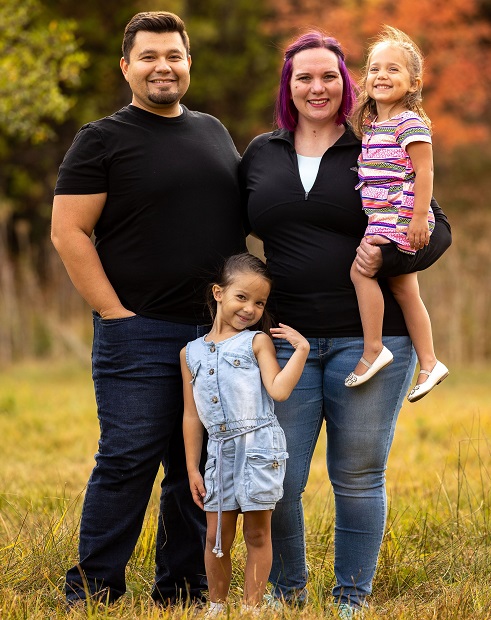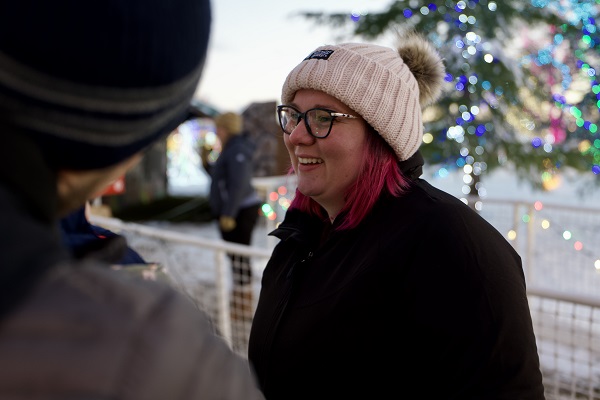
Before Springboard, Sadie Rubio worked part-time teaching jobs so she could remain at home with her two young daughters. When her daughters reached school age, Sadie realized she wanted a career. That’s when she discovered UX design and fell in love with it. As a former teacher, Sadie has always been fascinated by why people do what they do and what motivates them—hence her passion for true crime.
She loved helping students grasp difficult concepts as a teacher and being in a classroom invigorated her, but after a few years she wanted to try something new. Now, she’s a UX designer at a healthcare company called Lumea, a market leader in digital pathology solutions.
Before Springboard, I was primarily a mom. I focused on my kids, but because of how expensive the world is, I worked part-time, work-from-home jobs in the education field. I would work early in the morning and any time the kids were asleep.
Then I realized that if I was going to be working for the foreseeable future, I wanted my earnings to justify the time I am taking away from my family. That’s when I started to think, what are the talents and skills that I need in order to grow and move forward? My husband had told me about UX design, and that’s when I found Springboard.
Being able to understand people and why they do what they do is what interests me most–I've always been fascinated by that. At one point, I wondered if psychology was the route that I wanted to take, but then I found a way to learn about consumer psychology in the tech industry.
It came down to finding something I was passionate about and where I could earn a decent salary. Even when I was in college—I have an English degree—but I purposely chose not to go the English education route, because even at that time I knew that education wasn't the field that I wanted to work in long-term.

It's been really good. I’m really grateful for my team. The company is in the medical industry, so there’s a lot of terminology as well as processes and procedures that are unique to the field.
The team is new so we're all trying to find exactly what role we fit in into. At the moment, I support another team member to conduct research. There's one UX researcher and one designer on the team and I'm the bridge between them, because I can do a little bit of both. We are working on conducting interviews and surveys to make sure we are designing the correct product in the right way, instead of just designing something according to our assumptions. Even though I’ve been there for a short time, I’ve already pushed for more research than they typically do for other projects.
Yes.
Before I found Springboard, I had purchased a subscription to a design course that was entirely self-paced. But as a mom who was working part-time, I never made it a priority because there was always something else that needed to be done and my studies always got pushed to the side.
So when I started to browse UX design programs, I knew I needed something that would keep me accountable, but I also needed flexibility. That's why I chose Springboard. I knew the weekly calls with a mentor would keep me accountable.
My mentor was Danny Ledger [director at Jungle Research Studio]. I loved my mentor and the relationship we had. He really understood what I needed and was able to push me, but he also didn't push me too much. He understood that I had little kids. There were a lot of times throughout the course where I doubted myself and my abilities and he would listen to me vent and tell me, "You've got this." He was really good at giving a balance of support and accountability.
My first capstone project was a passion project. I created an app called Essence that was a combination between a menstrual cycle tracking app and a daily planner calendar. I wanted to combine both worlds so that women could see how their menstrual cycle affects their daily motivation, productivity, and energy levels. I think it's a brilliant idea that we don't think of enough because anyone who has had a period recognizes how much your hormones impact your ability to accomplish things on a daily basis.
ne of the things I was unaware of before I started was just how many meetings I would be in because UX is such a collaborative process. It's not a bad thing because I think that through this collaboration, I'm able to learn a lot more and you get more ideas when more people are involved.
Another thing I didn’t see coming was having to defend my design ideas when the company or the client wants it to be a different way even if it means sacrificing good design. But that’s one thing I’ve learned that could haven’t been explained in a classroom.
Definitely my mentor. One, because of the relationship we had and; two, because of the accountability my mentor gave me. I know that I would still be waiting to get stuff done if I didn't have those weekly mentor calls.
When you make a career switch, you have to really want it and be prepared for the amount of time it may take to get the right position. This is the position I need to be in and I am really grateful for my team. I don't feel like I am a junior designer or that I can't contribute. So keep in mind that it's going to take a while and the position that is right for you may not be open yet, but it will be worth it.









